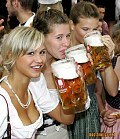New research using magnetic resonance imageing (MRI) is challenging conventional views regarding atherosclerosis and latent heart problems in patients that otherwise appear healthy.
By tagging different tissue prior to a scan, researchers can obtain a detailed view of the movement and function of those tissues. Now, by studying subjects in the Multi-Ethnic Study of Atherosclerosis (MESA) project, Joao Lima of the Department of Radiology, at Johns Hopkins University, in Baltimore, Maryland, and colleagues there and in five other centres, have investigated whether an increase in the thickness of the carotid artery (so-called intima-media thickness, or IMT) can be related to reduced heart function. The MESA study is a prospective observational study including four ethnic groups and the participants have no clinical cardiovascular disease.
You can read the full story in the first July update of spectroscopyNOW.com


 Beer is better for you than wine, apparently. Beer contains valuable B vitamins, such as B12, folic acid and niacin, as well as antioxidants, such as polyphenols and ferulic acid. Which makes it the healthier choice, contrary to popular opinion. her also contains soluble fibre, which is good for digestion. Even the “active” ingredient in alcohol, whether from beer or wine, allegedly helps keep arteries clear of blockages.
Beer is better for you than wine, apparently. Beer contains valuable B vitamins, such as B12, folic acid and niacin, as well as antioxidants, such as polyphenols and ferulic acid. Which makes it the healthier choice, contrary to popular opinion. her also contains soluble fibre, which is good for digestion. Even the “active” ingredient in alcohol, whether from beer or wine, allegedly helps keep arteries clear of blockages.